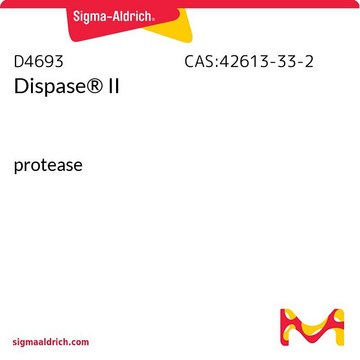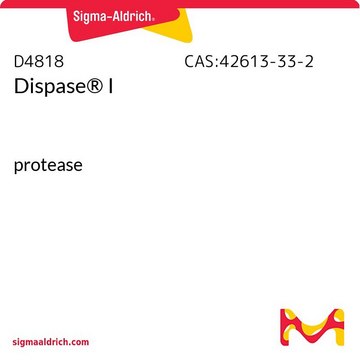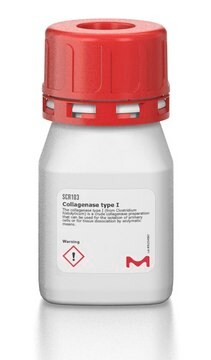B20223
Mieszanka kolagenazy - DNazy I - Dyspazy II
Tissue dissociation blend, lyophilized powder, suitable for cell culture
Synonim(y):
5′-oligonukleotydohydrolaza dezoksyrybonukleinianowa, Clostridium histolyticum, DNaza I, Deoksyrybonukleaza I, Dispase II, Klostridiopeptydaza A, Proteaza z Bacillus polymyxa, kolagenaza, mieszanka dysocjacji tkanek, mieszanka enzymów, mieszanka kolagenazy
About This Item
Polecane produkty
Poziom jakości
Formularz
lyophilized powder
aktywność właściwa
≥2 units/mL Dispase II
stężenie
0.1 mg/mL (DNase)
1 mg/mL (collagenase)
metody
cell culture | mammalian: suitable
Warunki transportu
dry ice
temp. przechowywania
-10 to -25°C
Opis ogólny
Działania biochem./fizjol.
Uwaga dotycząca przygotowania
Hasło ostrzegawcze
Danger
Zwroty wskazujące rodzaj zagrożenia
Zwroty wskazujące środki ostrożności
Klasyfikacja zagrożeń
Eye Irrit. 2 - Resp. Sens. 1 - Skin Irrit. 2 - STOT SE 3
Organy docelowe
Respiratory system
Kod klasy składowania
11 - Combustible Solids
Klasa zagrożenia wodnego (WGK)
WGK 3
Wybierz jedną z najnowszych wersji:
Certyfikaty analizy (CoA)
It looks like we've run into a problem, but you can still download Certificates of Analysis from our Dokumenty section.
Proszę o kontakt, jeśli potrzebna jest pomoc Obsługa Klienta
Masz już ten produkt?
Dokumenty związane z niedawno zakupionymi produktami zostały zamieszczone w Bibliotece dokumentów.
Nasz zespół naukowców ma doświadczenie we wszystkich obszarach badań, w tym w naukach przyrodniczych, materiałoznawstwie, syntezie chemicznej, chromatografii, analityce i wielu innych dziedzinach.
Skontaktuj się z zespołem ds. pomocy technicznej










